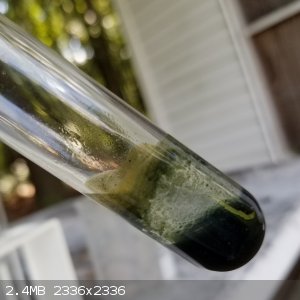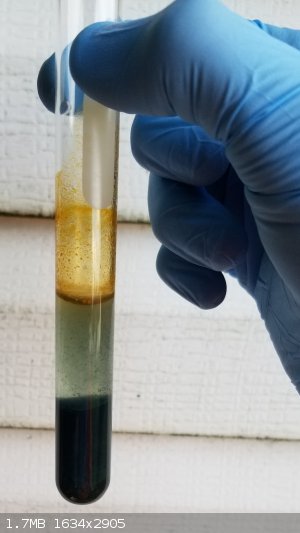AlChemicalLife
Harmless

Posts: 37
Registered: 18-1-2011
Member Is Offline
Mood: happy and ready for science
|
|
Cyanide from Charcoal and KNO3?
So, today I thought I would do some testing and see if I could get any trace amounts of cyanide from burning KNO3 and Charcoal together. I was
interested because I'm a pyro and have an interest in knowing the bi-products. I saw a thread on here a while ago that mentioned something about this.
So I mixed 5 grams of potassium nitrate and 2 grams of charcoal, put this mix in a crucible and burned it.
After burning, I added water to the slag left over and then mixed the solution around.
Then I filtered this solution through a coffee filter and put it in a brown bottle.
To test for cyanide I mixed 1gram of ferrous sulfate into 50ml's of DI water.
I Added the solution I wanted to test to a test tube.
I then added the ferrous sulfate to the solution of what I thought may contain trace amounts of cyanide.
To my surprise when I added the ferrous sulfate I got a green precipitate.
I'm suspecting this would be Iron Hydroxide but I also got a whiff of a weird smell, it didn't smell good. I took video of me doing all this and in
the video, you can hear me make a comment about how there is no sulfur I was aware of in the KNO3 or Charcoal but it still smelled bad.
As I let the test tubes sit, the solution settled and what looked to be iron oxide that formed but I wasn't able to see any blue color.
So my question really stand to these
1. Is there any trace of cyanides?
2. What was that smell, could I have gotten an impure sample of Ferrous sulfate from Home Science Tools that contained a copper(II) salt and caused
Copper (II) Cyanide to form and degrade into Copper (I) cyanide and Cyanogen? This is more of a concern form my health than for the test.
3. are there any other tests I could do in my small lab to show trace amounts of cyanide?
4. Where would the hydroxide come from in this reaction?
|
|
|
DraconicAcid
International Hazard
    
Posts: 4278
Registered: 1-2-2013
Location: The tiniest college campus ever....
Member Is Offline
Mood: Semi-victorious.
|
|
With nitrates, I suspect the biggest product would be potassium carbonate.
Please remember: "Filtrate" is not a verb.
Write up your lab reports the way your instructor wants them, not the way your ex-instructor wants them.
|
|
|
CobaltChloride
Hazard to Others
  
Posts: 239
Registered: 3-3-2018
Location: Romania
Member Is Offline
|
|
In order to test for cyanides you need to have both iron (II) and iron (III) in solution. You only had iron (II). That's why it didn't work.
In my experience molten potassium nitrate and nitrite react to a certain extent with CO2 to make carbonates. Your precipitate was FeCO3.
[Edited on 9-8-2018 by CobaltChloride]
|
|
|
GrayGhost-
Hazard to Self
 
Posts: 61
Registered: 31-10-2017
Location: Argentina
Member Is Offline
Mood: No Mood
|
|
According to patent of Mr Kellner say "When working with nitrates on a large scale, it will be advisable to melt the nitrate in a separate vessel and
mix the carbon there With gradually, so as to promote the partial transformation of the nitrate into nitrite. " Posibly to avoid ignition or
explosion, then this mixture go to electric arc furnace .
This part of process is very important .
|
|
|
DraconicAcid
International Hazard
    
Posts: 4278
Registered: 1-2-2013
Location: The tiniest college campus ever....
Member Is Offline
Mood: Semi-victorious.
|
|
I do recall reading somewhere in some old book about the formation of ferrocyanides by the heating of charcoal, iron filings and nitrogenous waste
material (I think it was protein-containing stuff like hair) in the absence of air. How's that for a crappy citation?
Please remember: "Filtrate" is not a verb.
Write up your lab reports the way your instructor wants them, not the way your ex-instructor wants them.
|
|
|
AlChemicalLife
Harmless

Posts: 37
Registered: 18-1-2011
Member Is Offline
Mood: happy and ready for science
|
|
So from what I take ,is that there is probably little to no cyanide production from this ( does not surprise me as many people use these different
compositions in pyro all the time and don't get poisoned from it ) . It takes special conditions and effort to get cyanide from this way. As I am not
actually interested in making cyanide , just was fascinated that a process and composition that I use to make fireworks could cause cyanide production
was interesting.
I still have one question though , I see that you guys say that there is potassium carbonate . If iron carbonate was being precipitated, why would it
be a greenish blue color? I have a picture of what It looked like if I could figure out how to post a picture here . I'm also trying to figure out the
smell I got a whiff of.
~Steven
|
|
|
Daffodile
Hazard to Others
  
Posts: 167
Registered: 7-3-2016
Location: Highways of Valhalla
Member Is Offline
Mood: Riding eternal
|
|
Steve, often certain oxidation states of the transition metals will have recognizable colors that you can identify easily once you get the hang of it.
Fe 2+ often has a greenish blue color that is useful for distinguishing it from Fe 3+.
Also OP you could try making ferrocyanide, I have found this to be a much better/ more reliable route to cyanides. Just heat Potassium Carbonate,
Urea, Iron bits, and Charcoal, mixed as much as possible, in somewhat stoichiometric proportions to glowing orange, preferably in an iron crucible.
Yellow product of Potassium Ferrocyanide can be separated from the shit left over via recrystallization, although there will be major Carbonate
contamination. You can get Cyanides from this by distilling the Hydrocyanic acid VERY CAREFULLY after the addition of Sulfuric Acid to the
Ferrocyanide salt. The distillation might be funky though because even in the coolest condensing setups I often have difficulty condensing the
Hydrocyanic Acid vapour.
|
|
|
clearly_not_atara
International Hazard
    
Posts: 2691
Registered: 3-11-2013
Member Is Offline
Mood: Big
|
|
Some hydrated ferrous carbonates are bluish.
https://en.m.wikipedia.org/wiki/Fougèrite
[Edited on 04-20-1969 by clearly_not_atara]
|
|
|
AlChemicalLife
Harmless

Posts: 37
Registered: 18-1-2011
Member Is Offline
Mood: happy and ready for science
|
|
Some photos of that precipitit
 
|
|
|
sumatra
Harmless

Posts: 25
Registered: 15-8-2018
Member Is Offline
|
|
Charcoal and coal especially naturally contain sulfur. Even activated charcoal contains trace amounts of sulfur and chances are that whatever charcoal
you buy there will be some S impurities. The carbon in batteries however shouldn't contain S, atleast not the extent of charcoal.
|
|
|
fusso
International Hazard
    
Posts: 1922
Registered: 23-6-2017
Location: 4 ∥ universes ahead of you
Member Is Offline
|
|
Quote: Originally posted by sumatra  | | Charcoal and coal especially naturally contain sulfur. Even activated charcoal contains trace amounts of sulfur and chances are that whatever charcoal
you buy there will be some S impurities. The carbon in batteries however shouldn't contain S, atleast not the extent of charcoal.
|
Why not just pyrolyse sugar? Sugar should be pure enough without processing, unlike battery gunk.
|
|
|
Hunterman2244
Hazard to Others
  
Posts: 105
Registered: 6-6-2018
Member Is Offline
|
|
Quote: Originally posted by fusso  | Quote: Originally posted by sumatra  | | Charcoal and coal especially naturally contain sulfur. Even activated charcoal contains trace amounts of sulfur and chances are that whatever charcoal
you buy there will be some S impurities. The carbon in batteries however shouldn't contain S, atleast not the extent of charcoal.
|
Why not just pyrolyse sugar? Sugar should be pure enough without processing, unlike battery gunk.
|
Just sugar and kno3 themselves produce a significant amount of Inc
|
|
|